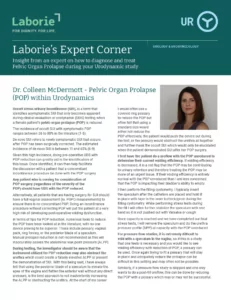What Is Occult Stress Urinary Incontinence?
Occult stress urinary incontinence (SUI), is a term that identifies asymptomatic SUI that only becomes apparent during clinical evaluation or urodynamic (UDS) testing when a female patient’s pelvic organ prolapse (POP) is reduced.
The incidence of occult SUI with symptomatic POP ranges between 36 to 80% in the literature (1-5).
De novo SUI refers to newly symptomatic SUI that occurs after POP has been surgically corrected. The estimated incidence of de novo SUI is between 11 and 65% (6-9). Given this high incidence, doing pre-operative UDS with POP reduction can greatly aid in the identification of this issue. Once identified, it can then help facilitate the discussion with a patient that a concomitant incontinence procedure be done with the POP surgery.
Given this high incidence, doing pre-operative UDS with POP reduction can greatly aid in the identification of this issue. Once identified, it can then help facilitate the discussion with a patient that a concomitant incontinence procedure be done with the POP surgery.
Any patient who is coming for consideration of POP surgery (regardless of the severity of the POP) should have UDS with the POP reduced.
Alternatively, all patients that are having surgery for SUI should have a full vaginal assessment (ie. POPQ measurements) to ensure there is no concomitant POP. Doing an incontinence procedure without correcting POP will put the patient at a very high risk of developing post-operative voiding dysfunction.
What Are the Top Tips for POP Reduction?
In terms of tips for POP reduction, numerous tools to reduce the POP have been looked at in the literature, with no one device proving to be superior. These include pessary, vaginal pack, ring forcep, or the posterior blade of a speculum. Manual prolapse reduction is not recommended as this will inaccurately assess the abdominal leak point pressure (ALPP).
During testing, the investigator should be aware that the instrument utilized for POP reduction may also obstruct the urethra which could create a falsely elevated ALPP or prevent the demonstration of SUI. With this being said, I have always felt that using the posterior blade of a speculum to elevate the apex of the vagina and flatten the anterior wall without any direct pressure, is the best approach to not inadvertently increasing the ALPP or obstructing the urethra. At the start of my career I would often use a covered ring pessary to reduce the POP but often felt that using a standard size would either not reduce the POP effectively, the patient would push the device out during the test, or the pessary would obstruct the urethra all together and further mask the occult SUI which would only be elucidated when the patient demonstrated SUI after her POP surgery.
I first have the patient do a uroflow with the POP unreduced to determine their current voiding efficiency. If voiding efficiency is decreased, it is a red flag that the POP may be contributing to urinary retention and therefore treating the POP may be more of an urgent issue. If their voiding efficiency is entirely normal with the POP unreduced than I am less concerned that the POP is impacting their bladder’s ability to empty.
I then perform the filling cystometry. I typically insert the speculum after the catheters are placed and hold it in place with tape to the inner buttock/groin during the filling cystometry. While performing stress tests during the fill I will often further stabilize the speculum with one hand so it is not pushed out with Valsalva or cough.
Once capacity is reached and we have completed our final stress tests, I will remove the speculum and do the urethra pressure profile (UPP) at capacity with the POP unreduced.
For pressure flow studies, it is extremely difficult to void with a speculum in the vagina, so if this is a study that one feels is necessary and you would like to see voiding efficiency with reduction of POP, a pessary can be used. Once again trying to fit a pessary that will stay in place and adequately reduce the prolapse can be difficult in this setting and may often not be possible.
Similarly, if a pressure flow study is skipped and one only wants to do a post-fill uroflow, this can be done by reducing the POP with a pessary which may or may not be successful.
When it comes to the use of ALPP or UPP to determine the severity of SUI, both are used to assess urethral sphincter mechanism. Unfortunately, both tests lack proper standardization, which makes it difficult to determine correct cutoff values and consequently, meaningful conclusions.
Very low values of both tests may indicate more severe sphincter insufficiency, but again, what are the low cutoff values? ALPP was originally described by McGuire (10) and was based upon Valsalva LPP (VLPP). They noted that 75% of women with SUI and a VLPP less than 60cmH2O had ISD, whereas most patients with a VLPP more than 90cmH2O had urethral hypermobility. Urethral pressure profilometry is thought to be a more objective way of measuring urethral function. Although low maximum urethral closure pressures (MUCP) are associated with SUI, there is no absolute cutoff figure below which the urethra can be implicated as the cause of incontinence. There are many continent women with low MUCP and incontinent women with high MUCP readings.
Essentially a combination of a low MUCP and a low ALPP may add weight to the diagnosis of intrinsic sphincter deficiency (ISD) but cannot definitively prove it. In addition, whether diagnosing ISD is helpful in predicting surgical outcome also remains controversial, many papers have been written with varying results.
As a result, I always do my ALPP measurements at 150ml increments during the filling cystometry with Valsalva measures at each point, and Valsalva and cough measures at maximum capacity. I will then measure the MUCP at the end of the fill (at the patient’s bladder capacity) when I am removing the catheter, as I often do not do a pressure flow study so it is an easy part to incorporate into the study and provides me with both types of measurements. I do not measure MUCP at rest, ie. after 50ml has been instilled into bladder, as I do not feel it has any clinical utility and adds another catheter insertion to the test which is obviously another point of discomfort.
Gathering this type of information with accurately performed UDS is incredibly important before surgical management of SUI, enabling an informed discussion with patients, and choosing an operation from those available.


